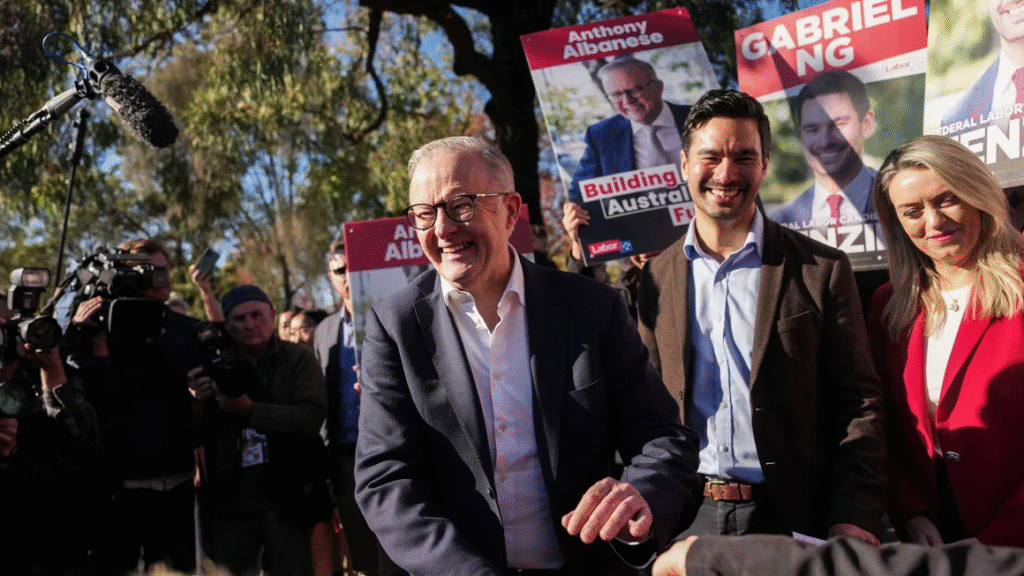Labor Party to Holds Power in Australia
Australia’s center-left Labor Party, led by Prime Minister Anthony Albanese, has won the 2025 federal election, retaining control of the government.

Networks project a majority for Labor, marking the first time since 2004 that a Labor leader has secured consecutive victories. The conservative Liberal Party leader, Peter Dutton, is projected to lose his seat in Dickson, Queensland, a stunning blow to the opposition.
Election Background
The election, held on May 3, 2025, saw 18 million Australians vote to decide the nation’s next government. Key issues included the cost-of-living crisis, housing affordability, and global uncertainty caused by U.S. President Donald Trump’s tariffs.
Both Labor and the Liberal-National Coalition focused on easing financial pressures, but Labor gained ground by emphasizing stability. Albanese’s campaign painted Dutton as a risky, Trump-like figure, a strategy that resonated with voters wary of global turmoil. The Coalition, once leading in polls, struggled after Trump’s policies sparked economic concerns.
Labor’s Victory and Dutton’s Defeat
Broadcasters, including Sky News and ABC, called the election for Labor as early results showed a swing toward the party.
Labor is projected to hold at least 78 seats in the 150-seat lower house, enough for a majority. In a major upset, Dutton trails Labor’s Ali France in Dickson, with early counts showing an 11.9% swing to Labor. France has 34.5% of votes compared to Dutton’s 30.7%. If Dutton loses, the Liberals must find a new leader, creating chaos for the opposition.
What Polls Predicted
Polls in the campaign’s final days favored Labor. A RedBridge-Accent poll showed Labor leading 53%-47% in the two-party preferred vote. YouGov predicted Labor could win up to 85 seats, while the Coalition faced its worst result since 1946. Millennials and Gen Z voters, concerned about housing and Trump’s policies, shifted support to Labor late in the race. The Coalition led polls in February but lost ground as global issues dominated.
Voter Opinions and Concerns
Voters expressed frustration with rising costs and housing shortages. Many, like Ben McCluskey in Sydney, backed Labor for its tax cuts and cost-of-living relief. Young voters in Dickson criticized Dutton’s leadership, citing economic struggles. Social media posts on X reflected joy among Labor supporters, with some calling Dutton’s potential loss a “protest vote” against the Coalition. Others worried about Labor’s policies, fearing overreach. Global instability, especially Trump’s tariffs, swayed swing voters toward Labor’s promise of steady leadership.
Other Election Highlights
The Greens held their ground in Brisbane but lost two Queensland seats to Labor. The “teal” independents, focused on climate and integrity, remained a force, potentially influencing a hung parliament if Labor’s majority falters. One Nation saw a late surge but didn’t shift the outcome. Labor’s win could lead to a minority government if outer metropolitan seats slip, though current projections suggest a clear majority.
What’s Next for Australia
Albanese vowed to invest in cost-of-living relief and housing while navigating global challenges. Dutton’s likely defeat has sparked Liberal Party infighting, with senior figures already planning leadership talks. The Coalition faces its lowest vote share in decades, forcing a rethink of its strategy. Labor’s victory signals voter preference for stability, but Albanese must deliver on promises to maintain trust.


 Trump Slaps Tariffs on Asian Nations, but India Secures Exemption
Trump Slaps Tariffs on Asian Nations, but India Secures Exemption  How InnoMake Shoes Make Navigation Safer for the Blind
How InnoMake Shoes Make Navigation Safer for the Blind  What’s New in Australia’s International Student Policy?
What’s New in Australia’s International Student Policy?  New Coronavirus Wave Hits India: What We Know
New Coronavirus Wave Hits India: What We Know  Trump Threatens 25% Tariff on iPhones and Other Smartphones
Trump Threatens 25% Tariff on iPhones and Other Smartphones  Did Trump Halt Harvard’s Foreign Enrollment?
Did Trump Halt Harvard’s Foreign Enrollment?